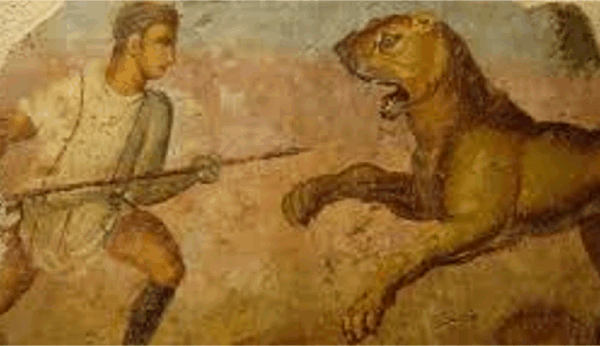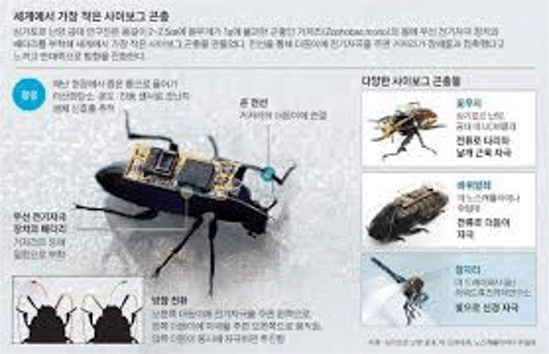ABC Science
주제: 고고학
6시간 전
로마 검투사가 표범과 싸우고, 표범의 가슴에 창을 찔러 피를 흘리는 모습을 담은 모자이크.
새로운 연구에 따르면 로마 매장지의 유골에서 대형 고양잇과 동물의 물린 자국으로 추정되는 흔적이 발견되었습니다. (위키미디어 커먼즈: 캐럴 라다토, CC BY-SA 2.0)
요약:
고고학자들은 영국에 있는 “검투사 묘지”로 추정되는 곳에서 발견된 유골을 분석한 결과, 사자나 호랑이와 같은 대형 고양잇과 동물의 물린 자국을 발견했습니다.
이는 로마 제국에서 검투사와 동물의 전투가 있었다는 최초의 물리적 증거입니다.
다음은 무엇일까요?
연구진은 동물의 흔적이 있는 다른 로마 유적도 발굴되기를 기대하고 있습니다.
로마 제국의 대중은 검투사들을 동물과 서로 싸우도록 강요당하며 검투사들을 떠올렸습니다.
하지만 검투사에 대한 로마 시대의 기록과 예술 작품은 풍부하지만, 그들의 유해는 매우 드뭅니다.
이제 고고학자 팀이 사망 직전, 또는 사망 직후 동물에게 물린 검투사의 시신을 발견했습니다.
오늘 PLOS One에 발표된 연구에 따르면, 3세기 영국에서 발견된 이 유골에는 사자나 호랑이와 같은 대형 고양잇과 동물의 물린 자국이 남아 있습니다.
포효하며 날카로운 이빨을 드러내는 수컷 사자.
할리우드 영화 속 검투사 전투 장면에는 사자가 자주 등장합니다. (Getty Images: skynesher)
이번 연구의 주저자인 아일랜드 메이누스 대학교 연구원 팀 톰슨은 구 로마 제국 전역에서 확인된 검투사 유해는 매우 적다고 밝혔습니다.
“이러한 유해에서 물린 자국이 확인된 것은 이번이 처음이라고 생각합니다.”
요크의 ‘검투사 묘지’
이 유골은 2004년 영국 요크 외곽 지역에서 발견된 유적지에서 발굴된 80구 이상의 유골 중 하나였습니다.
유골의 연대는 서기 1세기 또는 2세기 초에서 4세기 후반으로 추정됩니다. 당시 요크는 로마 제국의 중요한 군사 주둔지이자 도시였습니다.
유적지에서 발견된 유골은 거의 모두 남성이었으며, 사망 당시 18세에서 45세 사이의 연령이었습니다. 유골의 화학적 특성은 유골 중 일부가 로마 제국의 먼 지역 출신이었음을 시사합니다.
땅속 구덩이에서 유골을 파내는 고고학자들.
이 유적지는 2004년 요크의 드리필드 테라스 아래에서 처음 발견되었습니다. (로이터: 요크 고고학 트러스트)
유골은 상처투성이였습니다. 일부는 아물었지만, 일부는 사망 당시에도 상처가 있었습니다. 많은 유골이 뒤에서 참수된 상태였는데, 이는 처형의 징후일 가능성이 있습니다.
고고학자들은 확신할 수는 없지만, 시신의 인구 통계와 주변 증거를 바탕으로 이 매장지가 검투사 묘지일 가능성이 있다고 추정하고 있습니다.
큰 고양잇과 동물에게 물린 자국이 있는 검투사 유골
연구원들은 3D 스캐닝을 사용하여 서기 200년에서 300년 사이에 살았던 남성 유골 중 하나를 자세히 살펴보았습니다.
이 남성은 참수되었지만, 엉덩이뼈를 따라 이상한 둥근 자국이 있었습니다.
뼈 가장자리 쪽으로 둥글고 어두운 구멍이 있는 오래된 갈색 뼈의 근접 촬영.
유골의 왼쪽 엉덩이뼈에서 발견된 둥근 자국. (제공: 메이누스 대학교)
연구진은 이 자국을 스캔하여 동물원 동물들이 뼈를 씹어 만든 자국과 비교했습니다.
치타, 사자, 호랑이, 표범이 남긴 물린 자국은 이 남성의 자국과 매우 유사했습니다.
작은 구멍 자국이 있는 동물 뼈.
표범이 동물 뼈에 남긴 자국. (제공: Thompson et al., 2025, PLOS One, CC-BY 4.0)
톰슨 교수는 엉덩이 물린 자국이 피해자 사망 원인의 부상 증거일 가능성은 낮다고 말했습니다.
하지만 그는 사망 당시 동물이 남성을 땅바닥으로 끌고 갔을 때 부상이 발생했을 것으로 추정했습니다.
톰슨 교수는 “만약 연조직에 치명적 손상이 있었다면, 유골에는 그런 흔적이 보이지 않았을 것”이라고 말했습니다.
14cm와 5cm 길이의 자에 같은 뼈 조각을 찍은 두 장의 사진이 있는데, 뼈 끝에 1cm 정도의 둥근 틈이 있습니다.
오른쪽 엉덩이 뼈에도 큰 고양잇과 동물의 흔적이 있었습니다. (제공: Thompson et al., 2025, PLOS One, CC-BY 4.0)
연구진은 피해자의 참수가 동물의 공격 이후에 이루어졌을 것이라고 추정했습니다. 아마도 “그를 고통에서 벗어나게 하기 위해” 또는 관습을 따르기 위한 조치였을 것입니다.
연구에 참여하지 않은 맥쿼리 대학교의 로마 역사학자 레이 로렌스는 이 연구가 “꽤 설득력 있는” 증거를 제시했다고 말했습니다.
“큰 고양잇과 동물이 존재했다는 것을 밝혀낸 훌륭한 탐정 소설입니다.”라고 로렌스 교수는 말했습니다.
“로마 시대 영국에 큰 고양잇과 동물이 존재했다는 것은 매우 놀라운 일입니다.”
단 하나의 사례만으로는 동물의 흔적이 있는 검투사 유물이 얼마나 널리 퍼져 있었는지 파악하기 어렵습니다.
사람이 누워 있는 동안 사자가 사람의 다리를 물고 있는 사자 위로 뛰어오르는 모습이 새겨진 대리석 비석.
역사가들은 검투사들이 사자를 비롯한 다른 동물들과 싸웠던 것에 대해 알아내기 위해 예술 작품과 기록에 의존해 왔습니다. (출처: 대영 박물관 이사회, CC BY-NC-SA 4.0)
로마인들은 시신을 화장하는 것을 선호했습니다.
제국 역사의 여러 부분을 조사하다가 후대에 매장지로 전환했습니다. 이로 인해 로마 유적을 찾기가 더 어려워졌습니다.
하지만 로렌스 교수는 이 발견이 다른 고고학자들이 알려진 표본을 더 자세히 조사하도록 자극할 수 있다고 제안했습니다.
“이번 발표는 ‘내가 그걸 봤지만 출판하지 않고 창고에 보관해 두었다’는 식으로 더 많은 것을 보여줄 수 있을 것입니다.”
받은 편지함으로 과학을
ABC 전체의 최신 과학 기사를 받아보세요.
귀하의 정보는 ABC 개인정보 수집 정책에 따라 처리됩니다.
이 사이트는 reCAPTCHA의 보호를 받으며 Google 개인정보처리방침과 서비스 약관이 적용됩니다.
이메일 주소
ozilbo07@gmail.com
구독
6시간 전 게시
Skeleton from Roman gladiator cemetery was mauled by a lion or other big cat, archaeologists suggest
6h ago6 hours ago
In short:
Archaeologists have analysed a skeleton from a probable “gladiator graveyard” in the UK, and found bite marks from a big cat such as a lion or tiger.
It’s the first physical evidence of gladiator-animal combat in the Roman Empire.
What’s next?
Researchers now hope other Roman remains with animal marks will emerge.
abc.net.au/news/roman-gladiator-big-cat-lion-bite-marks-archaeology-teeth/105202234
Link copiedShare article
Forced to fight animals and each other for entertainment, gladiators loom large in the public imagination of the Roman Empire.
But while there’s plenty of Roman writing and art about gladiators, their bodily remains are rare.
Now, a team of archaeologists has found what they claim to be the body of a gladiator who was bitten by an animal while — or just after — he died.
The skeleton, from third-century Britain, has bite marks from a big cat such as a lion or tiger, according to a study published in PLOS One today.
Study lead author Tim Thompson, a researcher at Maynooth University in Ireland, said there were very few confirmed gladiator remains across the former Roman Empire.
“We believe this to be the first example that a bite mark has been identified on such remains.”
York’s ‘gladiator graveyard’
The skeleton was one of more than 80 excavated from a site discovered outside the UK city of York in 2004.
The bodies date from the first or early second century AD, to the late fourth century AD. During this time, York was an important military garrison and city in the Roman Empire.
Almost all of the skeletons found at the site were male, aged from 18 to 45 years at time of death. Chemical signatures in the bones suggest several of the men hailed from distant parts of the empire.
The bodies were riddled with injuries — some had healed, while others were sustained when they died. Many of the bodies had also been decapitated from behind, which may be a sign of execution.
While they can’t be certain, archaeologists believe that the burial site may be a gladiator cemetery, based on the demographics of the bodies and the evidence around them.
Gladiator skeleton with big cat bite marks
The researchers used 3D scanning to look closely at one of the skeletons, a man who lived between AD 200 — 300.
The man had been decapitated, but he also had curious round marks along his hip bones.
The team scanned the marks and compared them to those made by zoo animals chewing bones.
Bite marks made by cheetahs, lions, tigers and leopards resembled the man’s marks very closely.
Professor Thompson said that the hip bite marks are unlikely to be evidence of the injury that killed the victim.
But he believed the injuries occurred at the time of death, with an animal dragging the man along the ground.
“If a fatal injury involved the soft tissues, this wouldn’t be seen on the skeleton,” Professor Thompson said.
The researchers suggested that the victim’s decapitation happened after the animal attack — either to “put him out of his misery”, or to follow custom.
Ray Laurence, a Roman historian at Macquarie University who wasn’t involved in the research, said that the study presented “pretty compelling” evidence.
“It’s a great detective story in terms of working out that a big cat was present,” Professor Laurence said.
“The presence of big cats in Roman Britain is quite remarkable.”
With just one example, it’s difficult to tell how widespread gladiator remains with animal marks may be.
Romans preferred to cremate their dead for long swathes of the empire’s history, switching to burial in later centuries. This makes it harder to find Roman remains.
But Professor Laurence suggested that this discovery might prompt other archaeologists to look at known specimens more closely.
“The publication may lead to more going: ‘I saw that and we never got around to publishing it, and we put it in a storeroom.’”
Science in your inbox
Get all the latest science stories from across the ABC.
Your information is being handled in accordance with the ABC Privacy Collection Statement.
This site is protected by reCAPTCHA and the Google Privacy Policy and Terms of Service apply.
https://www.google.com/recaptcha/api2/anchor?ar=1&k=6LcNjL8lAAAAAB3chG8dvYH2LKi33r9xFw0kihjQ&co=aHR0cHM6Ly93d3cuYWJjLm5ldC5hdTo0NDM.&hl=ko&type=image&v=ItfkQiGBlJDHuTkOhlT3zHpB&theme=light&size=invisible&badge=bottomright&cb=sok4f31vpd9yEmail addressSubscribe
Posted 6h ago










